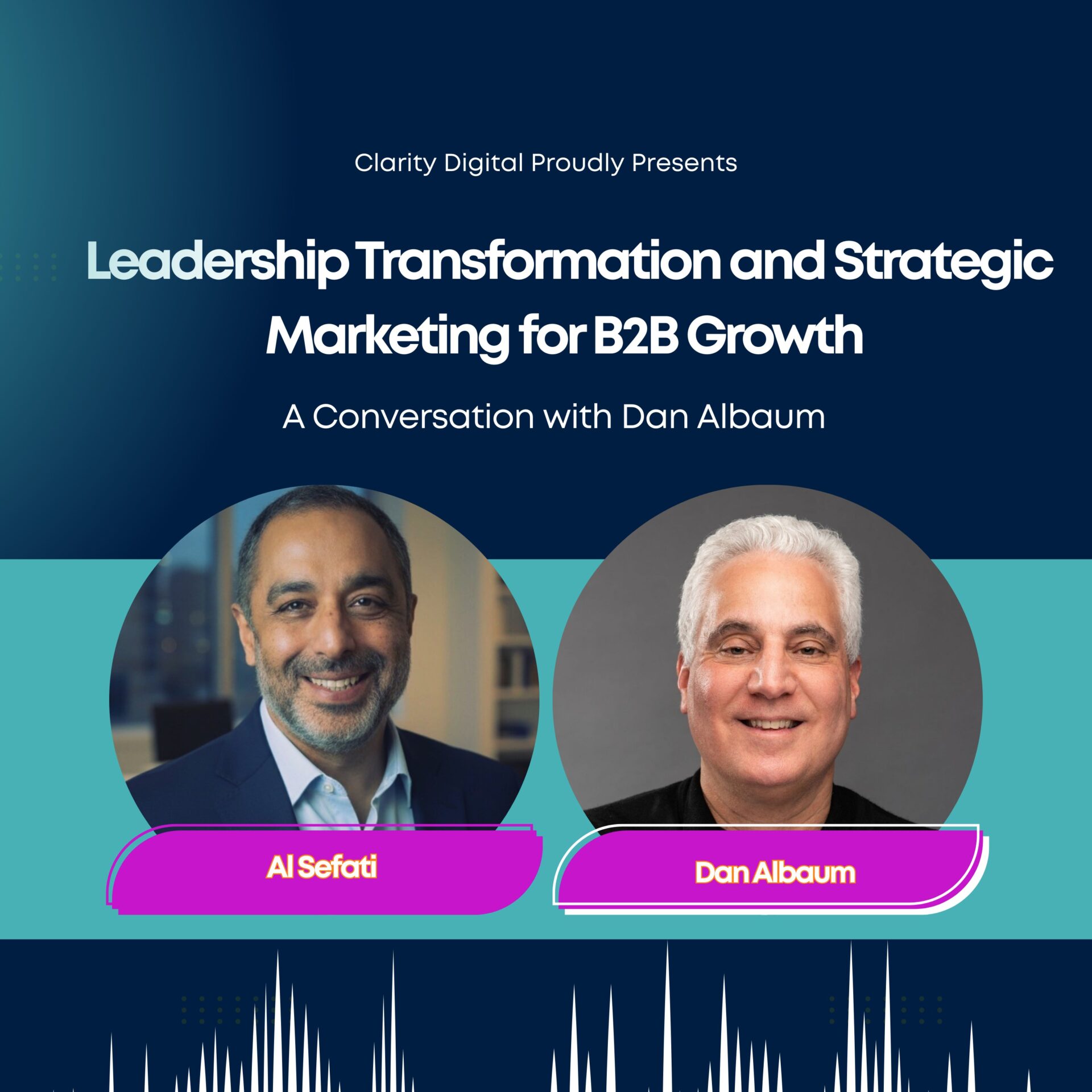A conversation with Juliana Pereira
In this episode of the Clarity Digital Pod, I sat down with Juliana Pereira, a marketing strategist and former SaaS marketing leader who helped guide Flow Commerce from post–Series A to a $500 million acquisition. Her background spans nonprofit, B2C, enterprise, and B2B SaaS — and that broad experience informs how she approaches marketing today: not as a siloed function, but as a business-critical leadership discipline.
If you’re leading growth at a B2B or SaaS company, or you’re a founder looking to scale with strategic marketing, this conversation is packed with hard-earned lessons you’ll want to apply.
From Museums to Multimillion-Dollar SaaS
Juliana’s career path is anything but linear. She began in the nonprofit world, running eCommerce for a museum, then shifted into B2C marketing, followed by a role at Ralph Lauren managing wholesale eCommerce. Eventually, she transitioned into B2B SaaS, joining Smartling, a localization tech company, before moving to Flow Commerce, where she served as head of marketing.
At Flow, she joined just after Series A funding and led marketing through three and a half years of hypergrowth, culminating in a $500 million exit. She wasn’t just leading campaigns — she was aligning marketing with sales, operations, partnerships, and product.
That distinction is important. Juliana doesn’t treat marketing like a department. She treats it like a business driver.
The Problem with “Functional-Only” Marketing
A major theme we unpacked in the episode was the difference between functional marketing and business marketing.
Functional marketing focuses on tactics: SEO, paid media, content, social, events, and automation. All of these are essential, but when marketing stays locked in this mode, it becomes reactive and siloed. Juliana argues that marketing must rise to the level of business leadership — influencing strategy across every department.
“We’re the tugboat in front of the ship,” Juliana said. “Marketing sees the fog, the storm, the iceberg — we have to be the first to pivot and help the rest of the business move with us.”
That’s the mindset shift. Instead of waiting for product or sales to dictate priorities, marketing should be plugged into every key initiative: onboarding, retention, revenue, customer feedback, tech limitations, and even hiring.
How to Build Marketing That Drives Business Outcomes
At Flow, Juliana was brought in to stand up marketing from the ground up. There was no sales leader yet, no RevOps. She didn’t wait for roles to be filled — she stepped in.
She owned:
- SDR team development
- Revenue operations (including HubSpot and CRM systems)
- Demand generation strategy
- Sales enablement
- Partner marketing
- Branding and messaging
- Strategic content and PR
Her playbook focused on three priority layers:
- Low-hanging fruit – Quick wins like fixing long forms, updating calls-to-action, and improving conversion points.
- Short-term wins – Tactics that support quarterly revenue targets, such as performance campaigns or account-based outreach.
- Long-term growth – Larger strategic projects like brand positioning, event strategy, and thought leadership.
She didn’t prioritize rebranding or cosmetic updates unless they had a clear impact on the business. One example: she delayed Flow’s rebrand for nearly two years until a major partnership deal created the right moment to use branding strategically.
Marketing and Sales: One Funnel, Shared Ownership
Too often, marketing and sales are split by process, tools, and incentives. Juliana sees them as two sides of the same coin. In her model, they work from the same list, target the same accounts, and report on shared metrics.
Instead of just MQLs, Juliana focuses on:
- Net new meetings booked
- Pipeline generated
- Campaign influence
This last one matters. Attribution debates often slow teams down. Her solution? Stop fighting over who sourced the lead, and start looking at who influenced the deal.
“Marketing is often the reason a meeting happens — even if sales set it up. And sales is often the reason a deal closes — even if marketing warmed it up.”
That alignment allows teams to stop fighting for credit and start collaborating around outcomes.
How Marketing Builds Trust Inside Startups
Early-stage companies often run lean. Founders stay hands-on. Tech teams juggle priorities. In that environment, trust becomes everything.
Juliana shared a key framework: trust is like a shared bank account. You make deposits over time through smart decisions, clear communication, and follow-through. You only get to withdraw trust when you’re asking leadership to take a risk — and if that bet pays off, trust grows.
She gave an example where a CEO pushed for more Twitter activity. Instead of pushing back emotionally, she reframed the conversation:
“Is tweeting to 1,200 mostly investor followers going to move the needle today? Or should we focus on building pipeline and authority?”
That logic landed. Because she had already made several trust deposits, leadership gave her the room to prioritize.
Working Cross-Functionally with Product and Tech
Marketing doesn’t live in a vacuum. But in many companies, the relationship between marketing and product or tech can feel strained — especially when marketing requests are seen as distractions.
Juliana’s approach is collaborative:
- Train marketers to be self-sufficient with tools like Webflow or basic HTML
- Build relationships with product and engineering by supporting their goals
- Offer visibility into how marketing supports their initiatives
- Negotiate trade-offs instead of demanding timelines
She also believes in mentoring marketers to work like business leaders. That includes owning planning cycles, reporting with confidence, and staying proactive rather than reactive. Her advice to up-and-coming marketers: take a weekend, build a simple roadmap, and start thinking two to three quarters ahead.
Life Outside of Marketing
When she’s not building demand engines, Juliana is a professional violinist. She performs in New York and internationally and balances her creative side with a deep commitment to community work and nonprofit boards.
She also recommends a couple of impactful books for anyone in leadership:
- Man’s Search for Meaning by Viktor Frankl
- Stumbling on Happiness by Daniel Gilbert
Both offer lessons in resilience, purpose, and reframing challenges — skills that apply directly to leading marketing in a fast-changing world.
Marketing Should Drive More than Just Leads; It Should Drive Alignment & Growth
Juliana Pereira’s story is proof that when marketing is done right, it drives more than leads — it drives strategy, alignment, and growth. Whether you’re operating inside a startup or scaling an established SaaS company, the path to smarter marketing is treating it like a core business engine, not just a department.
You can connect with Juliana Pereira on LinkedIn, or check out her soon-to-launch consulting brand at jaypereiraconsulting.com.
For more insights from operators and growth leaders building with clarity, subscribe to Clarity Digital Pod wherever you listen.





